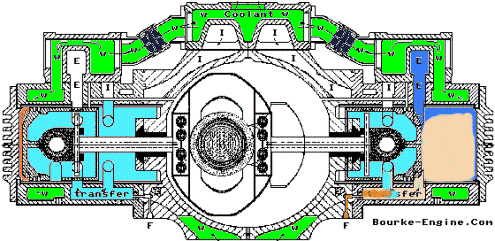I also forgot to mention that I just got done building a 3D printer so I can print mockup parts and casting negatives to cast parts such as the piston. The piston is a unique deflector type which I will be making from aluminum bronze.
The crankshaft will be a "tunnel style" crankshaft, the crankpin/journal bearings will use one piece superposed triple slipper bearings. That is, a solid bronze bearing in a bearing in a bearing. The main bearings will have a total of four main bearings for two cylinders. Two 4" diameter NK105 disc type roller bearings, and two 1.25" conventional pressurized plain bearings.
The objective goals of this engine project is to create and engine with a greater than 75% thermal efficiency (I'm shooting for at least 80%) yet be simpler in design with less moving parts than a lister engine, last at least 3 million miles before an overhaul is needed, and no ignition system necessary at all. Only a glow plug for startup on a cold day. Its designed to be able to be top overhauled in less than 5 minutes and the crankcase overhaul in less than 10 minutes. If the crankshaft breaks it will break the crankpin which is a 30 dollar part because the crankshaft is made of three pieces which allows the use of solid bearings and other unique bearing designs as well as easy changeouts. The cylinders pull off like a Harley V-twin. And my long term goal is to integrate flanges into the block which will allow the engine, with crankshaft plates to replace an output crankdisk with a joining crankdisk, to bolt together front to back to increase engine length so that three universal mass manufactured displacements, a 3 CID, 30 CID, and 200 CID, can cover everything from weed wackers to ships, trains, planes and everything in between.


If you guys here need anything 3D printed let me know.
The crankshaft will be a "tunnel style" crankshaft, the crankpin/journal bearings will use one piece superposed triple slipper bearings. That is, a solid bronze bearing in a bearing in a bearing. The main bearings will have a total of four main bearings for two cylinders. Two 4" diameter NK105 disc type roller bearings, and two 1.25" conventional pressurized plain bearings.
The objective goals of this engine project is to create and engine with a greater than 75% thermal efficiency (I'm shooting for at least 80%) yet be simpler in design with less moving parts than a lister engine, last at least 3 million miles before an overhaul is needed, and no ignition system necessary at all. Only a glow plug for startup on a cold day. Its designed to be able to be top overhauled in less than 5 minutes and the crankcase overhaul in less than 10 minutes. If the crankshaft breaks it will break the crankpin which is a 30 dollar part because the crankshaft is made of three pieces which allows the use of solid bearings and other unique bearing designs as well as easy changeouts. The cylinders pull off like a Harley V-twin. And my long term goal is to integrate flanges into the block which will allow the engine, with crankshaft plates to replace an output crankdisk with a joining crankdisk, to bolt together front to back to increase engine length so that three universal mass manufactured displacements, a 3 CID, 30 CID, and 200 CID, can cover everything from weed wackers to ships, trains, planes and everything in between.


If you guys here need anything 3D printed let me know.







